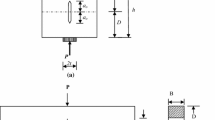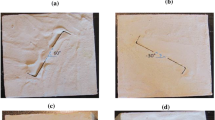Abstract
In this study, utilizing the boundary collocation approach based on the generalized Westergaard formulation developed by Sanford, alternative splitting strips with various ratios of length/depth, L/h = 0.5, 0.75, 1.25, and 1.5, were first discussed for fracture mechanics of quasi-brittle materials for different load-distributed widths. By modifying Sanford's approach, some formulae calculating the tensile capacity of materials were subsequently proposed for strips without notches. To determine the simulating capacity of the split-tension strips on the fracture behavior of quasi-brittle materials, the formulas derived in this study were also applied to a popular fracture approach, the two-parameter model (TPM) in concrete fracture. As a result of the stress analysis based on this application, a square prismatic specimen type with edge crack was proposed to determine the fracture parameters of quasi-brittle materials. Subsequently, an experimental investigation on splitting cubes with edge cracks (L/h = 0.5) was performed. The analysis of this specimen based on TPM yielded viable and promising results.













Similar content being viewed by others
References
Tang, T., Shah, S.P., Ouyang, C.: Fracture mechanics and size effect of concrete in tension. ASCE J. Struct. Eng. 118, 3169–3185 (1992)
Sanford, R.J.: Principles of Fracture Mechanics. Prentice-Hall, New Jersey, USA (2003)
Kundu, T.: Fundamentals of Fracture Mechanics. CRC Press, Boca Raton (2008)
Popov, V.Z., Morozov, E.M.: Elastic-Plastic Fracture Mechanics. Mir Publishers, Moscow (1978)
Ukadgaonker, V.G.: Theory of elasticity and fracture mechanics. PHI Learning, Delhi (2015)
Tang, T.: Effect of load-distributed width on split tension of unnotched and notched cylindrical specimens. J. Test Eva. 22, 401–409 (1994)
Rocco, C., Guinea, G.V., Planas, J., Elices, M.: Size effect and boundary condition in the Brazilian tests: theoretical analysis. Mater. Struct. 32, 437–444 (1999)
Ince, R.: Determination of concrete fracture parameters based on two-parameter and size effect models using split-tension cubes. Eng. Fract. Mech. 77, 2233–2250 (2010)
Ince, R.: Determination of concrete fracture parameters based on peak-load method with diagonal split-tension cubes. Eng. Fract. Mech. 82, 100–114 (2012)
Ince, R.: Determination of the fracture parameters of the double-K model using weight functions of split-tension specimens. Eng. Fract. Mech. 96, 416–432 (2012)
Ince, R., Çetin, S.Y.: Effect of grading type of aggregate on fracture parameters of concrete. Mag. Conc. Res. 71(16), 860–868 (2019)
Ince, R.: The fracture mechanics formulas for split-tension strips. J. Theor. Appl. Mech. 55, 607–619 (2017)
Filon, L.N.G.: On the approximate solution of the bending of a beam of rectangular section. Trans. R. Soc. Lond. Ser. (A) 201, 63–155 (1903)
Davies, J.D., Bose, D.K.: Stress distribution in splitting tests. ACI J. 65, 662–669 (1968)
Schleeh, W.S.: Determination of the tensile strength of concrete. Beton 28(2), 57–62 (1978) (in German)
Neville, A.M.: Properties of Concrete, 4th edn. Longman, London (1995)
Timoshenko, S.P., Godier, J.N.: Theory of Elasticity, 3rd edn. McGraw Hill, New York (1970)
Tweed, J., Das, S.C., Rooke, D.P.: The stress intensity factor of a radial crack in a finite elastic disc. Int. J. Eng. Sci. 10, 323–335 (1972)
Tada, H., Paris, P.C., Irwin, G.R.: Stress Analysis of Cracks Handbook, 3rd edn. ASME Press, New York (2000)
Westergaard, H.M.: Bearing pressures and cracks. J. Appl. Mech. 61, A49-59 (1939)
Williams, M.L.: On the stress distribution at the base of a stationary crack. J. Appl. Mech. 24, 109–114 (1957)
Gross, B., Roberts, E., Srawley, J.E.: Elastic displacements for various edge-cracked plate specimens. Int. J. Fract. 4(3), 267–276 (1968)
Fett, T.: Stress Intensity Factors: T-Stresses—Weight Functions. KIT Scientific Publishing, Berlin (2008)
Sanford, R.J.: A critical re-examination of the Westergaard method for solving opening-mode crack problems. Mech. Res. Com. 6(5), 289–294 (1979)
Beardin, K., Dally, J.W., Sanford, R.J.: Experimental determination of KI for short internal cracks. J. App. Mech. 68, 937–943 (2001)
Hills, D.A., Kelly, P.A., Dai, D.N., Korsunsky, A.M.: Solution of Crack Problems: The Distributed Dislocation Technique. Springer, Berlin (1996)
Smith, R.N.L.: Basic Fracture Mechanics: Including an Introduction to Fatigue. Butterworth-Heinemann, Oxford (1991)
Gdoutos, E.E.: Fracture Mechanics Criteria and Applications. Kluwer Academic Publishers, London (1990)
Wu, X.R.: A review and verification of analytical weight function methods in fracture mechanics. Fatigue Fract. Eng. Mater. Struct. 42, 2017–2042 (2019)
Ince, R.: Usage of compact compression specimens to determine non-linear fracture parameters of concrete. Fatigue Fract. Eng. Mater. Struct. 44, 410–426 (2021)
Isida, M.: Effect of width and length on stress intensity factor of internally cracked plates under various boundary conditions. Int. J. Fract. 7(3), 301–316 (1971)
Wu, X.R., Carlsson, A.J.: Weight Functions and Stress Intensity Factor Solutions. Pergamon Press, Oxford (1991)
Kuliyev, S.A.: Conformal mapping function of a complex domain and its application. Arch. Appl. Mech. 90, 993–1003 (2020)
Tan, F., Zhang, Y., Li, Y.: An improved hybrid boundary node method for 2D crack problems. Arch. Appl. Mech. 85, 101–116 (2015)
Moaveni, S.: Finite Element Analysis Theory and Application with ANSYS. Pearson Education, London (2014)
Collatz, L.: The Numerical Treatment of Differential Equations. Springer, New York (1966)
Simon, K.M., Kishen, J.M.C.: A multiscale model for post-peak softening response of concrete and the role of microcracks in the interfacial transition zone. Arch. Appl. Mech. 88, 1105–1119 (2018)
Bazant, Z.P.: Size effect on structural strength: a review. Arch. Appl. Mech. 69, 703–725 (1999)
Weiβgrager, P., Leguillon, D., Becker, W.: A review of finite fracture mechanics: crack initiation at singular and non-singular stress raisers. Arch. Appl. Mech. 86, 375–401 (2016)
Jenq, Y.S., Shah, S.P.: Two-parameter fracture model for concrete. ASCE J. Eng. Mech. 111(10), 1227–1241 (1985)
ACI 318–11: Building Code Requirements for Structural Concrete and Commentary. American Concrete Institute, Farmington Hills (2011)
Yang, S., Tang, T., Zollinger, D.G., Gurjar, A.: Splitting tension tests to determine concrete fracture parameters by peak-load method. Adv. Cem. Based Mater. 5, 18–28 (1997)
Author information
Authors and Affiliations
Corresponding author
Additional information
Publisher's Note
Springer Nature remains neutral with regard to jurisdictional claims in published maps and institutional affiliations.
Rights and permissions
About this article
Cite this article
Ince, R. Utilization of splitting strips in fracture mechanics tests of quasi-brittle materials. Arch Appl Mech 91, 2661–2679 (2021). https://doi.org/10.1007/s00419-021-01913-5
Received:
Accepted:
Published:
Issue Date:
DOI: https://doi.org/10.1007/s00419-021-01913-5




